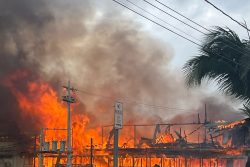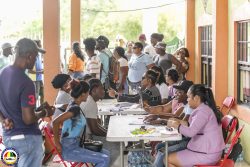Dear Editor,
My previous response (KN, January 1) to Annan Boodram’s letter (SN, December 31, 2009) on Rodney, Jagan, the WPA and the PPP sought to draw attention to the ethno-racial context and implication of his conclusions. Today I wish to expand on those observations. The discourse on race and ethnicity since 1992 has been driven by three narratives. First, the PPP and other Indian spokespersons have sought to justify the party’s decision to monopolize political power in contradiction of its earlier commitment to national reconciliation. This justification is premised on the belief that there is a historical desire on the part of Africans to deny political power to Indians and on the need to redress the wrongs committed by the PNC government against Indians. In short it’s the Indians turn to govern. This necessitated the construction of a narrative consistent with the above – a larger historical narrative of Indian suffering-victimhood and African guilt coupled with a narrative of extreme ethnic intent and content of the 1964-92 period. This narrative employs concepts such as ‘ethnic bullying’ and ‘African penchant for violence.’
This Indian narrative is complemented by an African narrative advocated by the PNC and other African activists sympathetic to that party. The political objective of this narrative is to justify the excesses of the PNC in the pre-1992 era and provide the basis for undermining the PPP government. The central thrust of this narrative is that there has always been an inherent desire by Indian Guyanese to dominate Africans; this desire is rooted in the cultural psyche of the Indians which locates Blackness at the bottom of their socio-cultural human ladder. This narrative privileges the post-1992 political developments, which are constructed as manifestations of African suffering and victimhood. It uses concepts such as ‘marginalization’ and ‘ethnic cleansing.’
The third narrative, a rejection of the two ethnic narratives, is a projection of national reconciliation and ethno-racial equality. Advocated mainly but not exclusively by present and former WPA members and supporters, it argues against the notion of a guilty race. In this regard it has sought to revise the narratives of guilt and innocence and construct one consistent with its objective of a national reconciliation based on ethnic equality and mutual security.
Mr Boodram’s letter is part of the Indian-PPP narrative. For reasons which are still contested, the PPP reneged on its commitment to ethno-national reconciliation at the level of government. Such actions had to be rationalized. The rationalization was two-fold. First, it was contended that the previous government, which was African-dominated had marginalized Indians, oppressed them and fraudulently and forcefully kept their party and their political leader out of power. Power cannot be shared with bullies. Second, resistance to the government came primarily from the PPP with others playing minor or limited roles. Power cannot be shared with mini-parties.
This grand narrative has been buttressed by several attendant constructions. One was an acknowledgement of Walter Rodney’s presence but a denial of his transformative role. It is in this context that the minimizing of the WPA’s role becomes important for the Indian narrative. Political history is in part about contestation for historical space. The absolute role of the vanguard PPP and its leader during the period in question is challenged by the existence of other significant forces such as the WPA and Rodney. Since it is foolhardy to deny that Rodney and the WPA existed, the alternative is to minimize their roles. It is in this context that Boodram’s forthright pronouncement of the death of Rodney and the WPA in 1980 must be understood. If the WPA was born in 1974, came of age in 1979 and died in 1980 then logically it was the PPP that carried the struggle for most of the period in question.
But the narrative still has to explain what happened while Rodney was alive. It has to explain what cannot be easily disputed – the multi-ethnic self-activity in the public space by thousands of Guyanese under the WPA’s banner. Here is where revolutionary romance comes in. Rodney is constructed as a romantic figure – brilliant historian and rhetoritician with whom the common folk were momentarily infatuated. But beyond that he was hopeless politically. As far back as 1979 Dr Jagan, at Howard University, described the WPA as a group of Black intellectuals and after Rodney’s death he characterized him as an adventurist. In the early 1990s Ravi Dev and the then Jaguar Committee for Democracy (JCD), which were instrumental in laying the groundwork for the post-1992 Indian narrative, dismissed the WPA’s multi-ethnic identity as a myth. They claimed that the WPA was essentially a Black Power-Pan Africanist outfit and that the Indians in the WPA accepted Black Power while denying Indian Power. Later on the PPP would tie the WPA to the PNC as two black peas in the same black pod and Dr Randy Persaud would locate the WPA as a part of a racial Black Nationalism.
This is the framework in which Mr Boodram’s political ridicule of Rodney must be seen – the romantic revolutionary with a ready embrace of violence fits into the stereotype of the Black Power nationalist and Africans in general whose history predisposes them to use violence to solve problems, as Ravi Dev once argued. This is the opposite of the non-violent Indian who instead of using violence on others turns the violence on himself. Hence, the resort to violence by Rodney and the rejection of violence by Dr Jagan. To read the narrative of Boodram and to some extent Ravi Dev, one who was not around in the 1970s would get the impression that Rodney and the WPA operated in the jungle as an armed guerilla outfit rather than on the urban and rural streets; that they maimed and killed. But in the final analysis if you locate Rodney and the WPA in a larger Black Power armed resistance praxis, you deny them space in the Guyanese resistance tradition based on non-violent militancy, mobilization from the bottom, mass political education and engagement of the formal political process, which is then left all to Dr Jagan and the PPP.
The analysis of Dr Jagan’s Marxism is another important aspect of the narrative. On the one hand his Marxism is used as proof that his was not a praxis based on race and ethnicity. Hence, Indians supported the PPP and Dr Jagan from a class perspective. Even when the Indian appeal is acknowledged, as Mr Boodram did in his letter, that appeal is confined to the working class Indians with no mention of elite Indian support. The other aspect of the narrative on Dr Jagan’s Marxism is the reframing of his legacy in pragmatic terms, which is the hardest sell. In fact, it was Dr Jagan who constantly criticized the WPA for not being true to scientific Marxism and who was part of the orthodox communist movement. But the construction of Dr Jagan and the PPP as the independent Marxist, which incidentally was how the WPA described itself in its programme and constitution, is part of the narrative of justification. This is where Boodram’s projection of Dr Jagan’s non-dogmatic Marxism comes from. In relation to Rodney and the WPA there is silence on their Marxism but emphasis on their Black Nationalism.
The notion of the guilty race is what drives another aspect of the Indian narrative – the call for the PNC to apologize. Apologize to whom? Not African Guyanese, because they did not suffer under the PNC. So it must be to Indian Guyanese. In our ethnic context such an apology would serve the purpose of admitting to ethno-racial guilt – the guilty African apologizing to the innocent Indian. My own preference is for a joint PPP-PNC apology to Guyana.
The larger implication of this narrative on Jagan-PPP and Rodney-WPA for ethnicity and race in Guyana is instructive. If the PPP were the leaders of the resistance to the PNC then Indians are the ones responsible for freedom. This fits into the historical narrative of the African as anti-progress. It was the Indians who saved the post-emancipation economy while Africans fled the plantation, the African police shooting Indians who protested colonial oppression, the Africans in the pre-1955 PPP not making sacrifice for the party and the struggle. The African becomes the obstacle to freedom. They are written out of positive history. Their history is a history of guilt and violence, never a history of freedom struggle. They could not have fought the PNC because the PNC was Black and even when non-PNC Africans emerged they were trapped in Black Nationalism. Burnham is Satan, with nothing virtuous. Kwayana is humble but a racial devil. Rodney is bright, but with no political substance or common sense. Never mind they opposed each other, they are all from the same violent, bullying history and culture.
Those of us who grapple with race and ethnicity outside of the confines of the race-based parties have a delicate balancing act – how to be critical of the party without condemning the race or how to defend the race without condoning the excesses of the party. This, to my mind, is what Ravi Dev is grappling with and on which Freddie Kissoon is pressing his buttons. But at least Ravi is grappling with it. Unfortunately for Mr Boodram he leaves no doubt about where he stands – Indian vanguardism in the guise of comparative party strength and relevance. His treatise is not about the examination of political events and actors but about the construction of truisms in pursuit of that vanguardism. It is what Kwayana once called “war propaganda.”
Yours faithfully,
David Hinds







